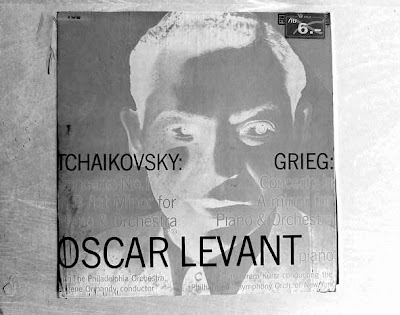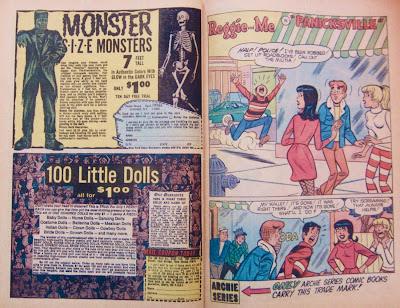Since I like to do things bass-ackwards, I'll spoil the
surprise right off the top. This is what you got.
When you sent away for them.
They came in one of these-here things.
A brown cardboard box with a suspicious rattle.
Close-up, they appeared larval, like this thing.
Looks a bit like the Elephant Man with a hat on.
It was this thing, see, this ad, this - didn't you used to read comic books, or what? How old are you? All right. I DO remember this ad, though since I didn't like dolls to begin with, I never sent away for them. Plus I could never scrape together a whole dollar anyway. My allowance always went on things like Lik-M-Ade, wax lips with red syrup in them and those sherbet fountains, the powdered stuff you sucked up with a liquorice straw. Once I bought a Hercules ring modelled after the Trans-Lux cartoons, but it broke the first day.
But to get back to these things, these 100 Dolls for a Dollar. I was suspicious. Just what were they talking about? What the hell was "Lilliputian cuteness"? (Jonathan Swift might have had a problem with that.) Was this just another Sea Monkey caper, another X-Ray Specs con? Another Grog Grows Own Tail? How many little girls were they disappointing, anyway - sending in their damp crumpled dollar bills in eager anticipation - only to get something that wouldn't caper, spec or grow?
As with the mind-boggling sex manual I just translated, I will attempt to make the grainy type from 50 years ago more decipherable:
100 Little Dolls all for $1.00
100 Dolls made of genuine styrene plastic and hard synthetic rubber only $1 for entire set. You get BABY DOLLS, NURSE DOLLS, DANCING DOLLS, FOREIGN DOLLS, CLOWN DOLLS, COWBOY DOLLS, BRIDE DOLLS, and many more in Lilliputian cuteness. And made not of paper or rags but of STYRENE plastic and hard synthetic rubber. If you don't go wild over them your money will be promptly refunded. Send $1.00 plus 25 cents for postage and handling for each set of 100 Dolls you order to: 100 Doll Co., Dept. 315, 285 Market St., P. O. Box 90, Newark, N. J.
People still have them, obviously, as these photos illustrate (and don't they just look like boxes full of dead insects?), and I would imagine that a complete set of 100 might fetch a handsome price on eBay or Craigslist, but what the hell would you DO with them? For that matter, what did little girls do back then when they received these rattling toothpicks, looking something like those plastic things you stick birthday candles into?
The fact that they seemed to come in two colors is confusing. The pink is no more fleshlike than the sickly Chee-toh orange.
But wait! Though it looks almost the same, THIS ad has completely different copy. It's effusive, it's gushing, it's pure Madison Avenue in the '60s: Peggy Olsen might have written it during her coffee break with her feet up on her desk, chewing Wrigley's spearmint gum:
Don’t shake your head in disbelief! This is TRUE! For only 1
PENNY EACH you can give that little girl the most thrilling present of her
life. This set of ONE HUNDRED DOLLS for only $1 – 1 penny A PIECE!
Baby Dolls – Nurse Dolls – Dancing Dolls
Costume Dolls – Ballerina Dolls – Mexican Dolls
Indian Dolls – Clown Dolls – Cowboy Dolls
Bride Dolls – Groom Dolls – and many more.
The wonder of this unprecedented offer is that every doll is
made from beautiful high-quality Styrene plastic and hard synthetic rubber. You
get BABY DOLLS, NURSE DOLLS, DANCING DOLLS, FOREIGN DOLLS, CLOWN DOLLS, COWBOY
DOLLS, BRIDE DOLLS and many more in Lilliputian cuteness. Your daughter or your
niece or the cute child next door will love you for this gift. She will play
with them for months and not grow weary of them. What a family for a little
girl! Just think of it – 100 exquisite little dolls – in beautiful high-impact
styrene plastic and hard synthetic rubber at this unbelievable price!
So fill out the coupon below. Order as many sets as you have
little girls to give them to. Enclose $1 for each 100 doll set you order. And
even at this amazing bargain you take no risk. If you don’t go absolutely wild
over this bargain, just send the Dolls back and we will promptly refund your
money.
(But don't go away, there’s more – to the ad, I mean! This freakin’
thing goes on forever.)
Our
Guarantee HERE IS WHAT THESE DOLLS ARE MADE OF
People seeing our ad, and not believing we can give such
value, write us to ask what our 100 Dolls are made of. “Are they paper dolls,
or rag dolls?” they ask. NEITHER! Each and every one of our 100 dolls is made
of GENUINE STYRENE and SYNTHETIC RUBBER, expensively molded in true dimension –
Height – Width – Depth! Every doll has come out of an individual mold,
manufactured out of high-impact styrene to resist breakage, and is life-like in
its proportions. They are truly delightful dolls!
How many times can you read the word "styrene" without puking? These people were obsessed with it. And all that hard rubber makes me worry. If these dolls had been a little less Lilliputian, if they had been, say, life-sized, think of the sin they might have spawned. But then they wouldn't have fit into that little brown box, would they?
And just what happened to the 100 Doll Company in Newark, New Jersey? Is it still there? Why did they only manufacture one thing? What sort of dolls would they be turning out in 2012: the kind that appear on TLC shows like My Strange Obsession?
Life slides me into tender melancholy, virtually daily, because I always think it was Better Back Then, more magical. It probably wasn't - I couldn't wait to grow up and get the hell away from school and my parents - but such is the power of nostalgia, a word that literally means "Don Draper pitching bullshit to a bunch of Kodak executives".
To be fair to the 100 Dolls Company, and to clarify any residual confusion, we should define Lilliputian once and for all.

Noun 1. lilliputian - a very small person (resembling a Lilliputian)
small person - a person of below average size
2. Lilliputian - a 6-inch tall inhabitant of Lilliput in a novel by Jonathan Swift Adj. 3. Lilliputian - tiny; relating to or characteristic of the imaginary country of Lilliput; "the Lilliputian population"
3. lilliputian - very small; "diminutive in stature"; "a lilliputian chest of drawers"; "her petite figure"; "tiny feet"; "the flyspeck nation of Bahrain moved toward democracy"
bantam, diminutive, flyspeck, midget, petite, tiny
little, small - limited or below average in number or quantity or magnitude or extent; "a little dining room"; "a little house"; "a small car"; "a little (or small) group"
3. lilliputian - (informal) small and of little importance; "a fiddling sum of money"; "a footling gesture"; "our worries are lilliputian compared with those of countries that are at war"; "a little (or small) matter"; "a dispute over niggling details"; "limited to petty enterprises"; "piffling efforts"; "giving a police officer a free meal may be against the law, but it seems to be a picayune infraction"
fiddling, footling, niggling, picayune, piddling, piffling, trivial, petty, little
colloquialism - a colloquial expression; characteristic of spoken or written communication that seeks to imitate informal speech
unimportant - not important; "a relatively unimportant feature of the system"; "the question seems unimportant"
Visit Margaret's Amazon Author Page!






























.jpg)










.jpg)

.jpg)
.jpg)


.jpg)









